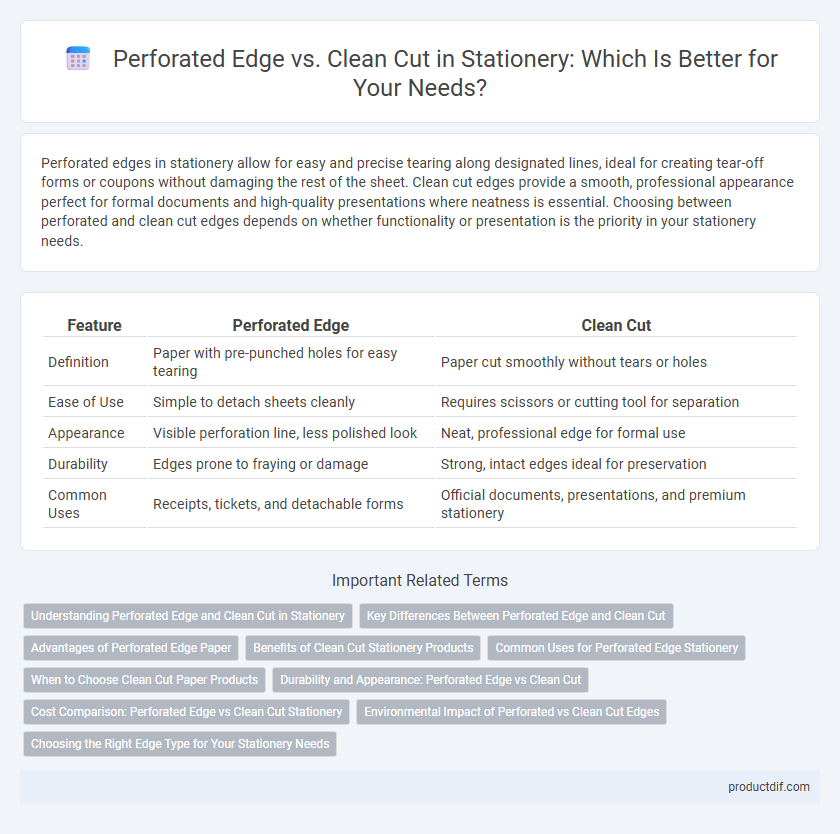Perforated edges in stationery allow for easy and precise tearing along designated lines, ideal for creating tear-off forms or coupons without damaging the rest of the sheet. Clean cut edges provide a smooth, professional appearance perfect for formal documents and high-quality presentations where neatness is essential. Choosing between perforated and clean cut edges depends on whether functionality or presentation is the priority in your stationery needs.
Table of Comparison
| Feature | Perforated Edge | Clean Cut |
|---|---|---|
| Definition | Paper with pre-punched holes for easy tearing | Paper cut smoothly without tears or holes |
| Ease of Use | Simple to detach sheets cleanly | Requires scissors or cutting tool for separation |
| Appearance | Visible perforation line, less polished look | Neat, professional edge for formal use |
| Durability | Edges prone to fraying or damage | Strong, intact edges ideal for preservation |
| Common Uses | Receipts, tickets, and detachable forms | Official documents, presentations, and premium stationery |
Understanding Perforated Edge and Clean Cut in Stationery
Perforated edge stationery features evenly spaced holes or slits that allow for easy and precise tearing along the designated line, ideal for coupons, tickets, or forms requiring separation. Clean cut stationery, on the other hand, has smooth, straight edges without perforations, offering a more polished and professional appearance suited for official documents or invitations. Understanding the functional differences between perforated edge and clean cut helps optimize stationery choice based on ease of use and presentation needs.
Key Differences Between Perforated Edge and Clean Cut
Perforated edges feature a series of small holes or cuts that allow for easy tearing and separation, commonly used in notebooks and tickets for convenience. Clean cuts provide a smooth, continuous edge that offers a more polished and professional appearance, preferred for presentations and formal documents. The key difference lies in functionality: perforated edges prioritize easy detachment, while clean cuts focus on aesthetic quality and structural integrity.
Advantages of Perforated Edge Paper
Perforated edge paper offers easy and precise tearing along predefined lines, reducing the risk of uneven or jagged edges often seen with clean cut sheets. It enhances organization by allowing users to separate sections quickly without damaging the overall document. This feature is especially advantageous in forms, tickets, and notebooks where frequent detachment is required.
Benefits of Clean Cut Stationery Products
Clean cut stationery products offer precise, smooth edges that enhance the professional appearance of documents and presentations. Unlike perforated edges, clean cuts provide durability and prevent fraying or tearing, ensuring longer-lasting quality. This precision is ideal for high-quality prints, formal invitations, and office use where aesthetics and integrity of the paper are crucial.
Common Uses for Perforated Edge Stationery
Perforated edge stationery is commonly used for documents that require easy separation, such as tickets, coupons, invoice duplicates, and forms that need to be retained while parts are distributed. This design facilitates clean and precise tearing without the need for scissors or other tools, enhancing convenience in offices and retail environments. Perforated edges also help in organizing paperwork by allowing quick detachment of sections for filing or sharing.
When to Choose Clean Cut Paper Products
Clean cut paper products are ideal for professional presentations, official documents, and formal correspondence where a polished, crisp appearance is crucial. They provide smooth, unbroken edges that enhance the overall impression of quality and attention to detail. Choose clean cut paper when precision and aesthetics are prioritized over flexibility in tearing or separation.
Durability and Appearance: Perforated Edge vs Clean Cut
Perforated edges offer easy tearability but may compromise durability due to weaker points along the perforations, whereas clean cut edges provide a smooth, intact finish that enhances longevity and maintains a polished appearance. Clean cut stationery resists fraying and damage over time, preserving a professional look ideal for formal documents. Though perforated edges add functionality for detachable sections, clean cut edges are preferable for maintaining structural integrity and an elegant presentation.
Cost Comparison: Perforated Edge vs Clean Cut Stationery
Perforated edge stationery typically incurs higher production costs due to the specialized die-cutting process required to create tearable sections, whereas clean cut stationery benefits from simpler, standard cutting methods that reduce manufacturing expenses. Bulk orders of clean cut stationery often yield lower unit prices, making it a cost-effective choice for businesses prioritizing budget efficiency. The added convenience of perforations may justify higher costs in specific applications such as coupons or tear-off forms, but for general office use, clean cut options remain more economical.
Environmental Impact of Perforated vs Clean Cut Edges
Perforated edges generate more paper waste due to the small, detached fragments produced during separation, increasing environmental burden. Clean cut edges minimize material loss and facilitate recycling by preserving paper integrity, reducing landfill contributions. Choosing clean cut stationery solutions supports sustainability by conserving resources and lowering overall environmental impact.
Choosing the Right Edge Type for Your Stationery Needs
Choosing between perforated edge and clean cut stationery depends on your specific needs for functionality and aesthetics. Perforated edges allow easy tearing and are ideal for tear-off forms, tickets, or vouchers, enhancing convenience and usability. Clean cut edges provide a polished, professional look suitable for formal invitations, business cards, and high-quality letterheads where a sleek presentation is essential.
Perforated Edge vs Clean Cut Infographic

 productdif.com
productdif.com